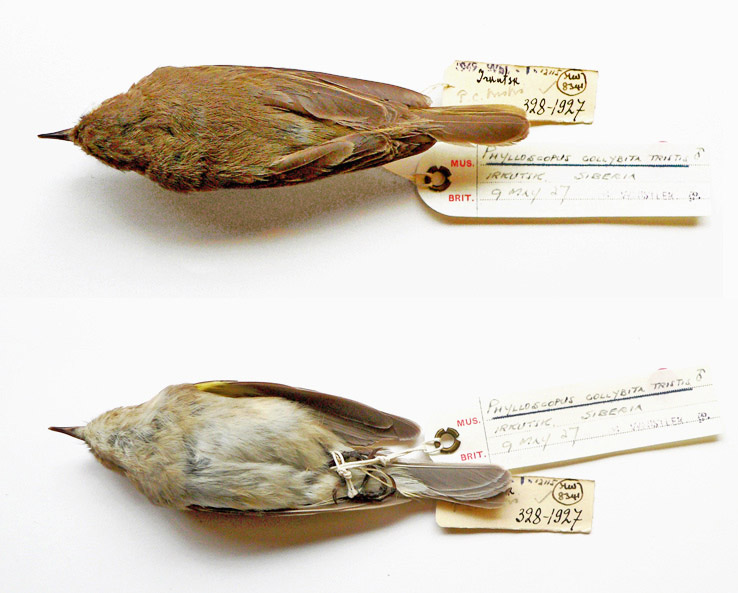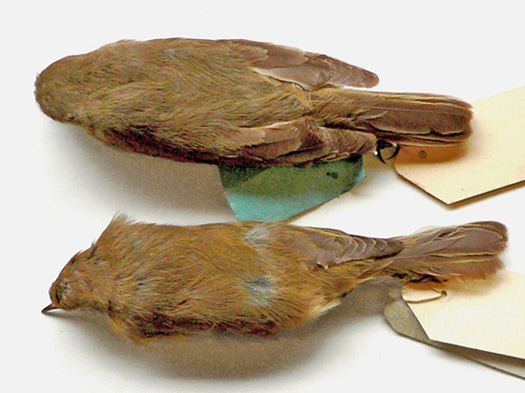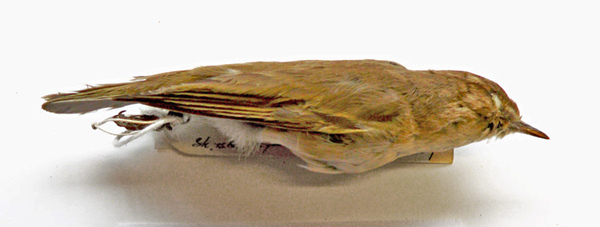Appendices |
Appendix 1.
The 'type description' of tristis
The original description of “Phylloscopus tristis” (Blyth 1843, Journ. Asiatic Soc. Bengal XII, p. 966-7) was based upon individuals on the wintering grounds in India and is as follows:
'Ph. tristis, Nobis. Closely allied to Ph. rufus, but devoid of any greenish or yellowish tinge on the plumage, except on the fore-part of the wing underneath, and faintly margining the quills and tail externally; legs and claws black, or rather dull black (much darker than in Ph. rufus), except the under-surface of the toes which is yellow; bill also blackish, tinged with yellow at base of lower mandible, and the gape also yellow. Length four inches and a half, by six inches and a half across; of wing two inches and one-eighth; tail an inch and three-quarters; bill to gape half an inch; and tarsus seven-sixteenths of an inch. General colour greyish-brown, beneath paler and albescent, a faint rufous tinge on the breast, and not trace of yellowish on the lower tail-coverts, nor elsewhere than as described.*
[Footnote] * There is the faintest possible greenish tinge on the upper-parts of some that I have since procured, which colour is most developed on the margins of the secondaries, towards their base.'
[Ed note: Ph. rufus was the scientific name for collybita and abietinus combined, before their separation.]
Individuals wintering in India may not all originate from eastern Siberia but the 'type description' conforms with modern interpretations of 'classic' tristis, viz. plumage lacking yellow away from the underwing and lacking olive except faintly on the margins of remiges and rectrices; upperparts grey-brown, underparts off-white with a faint 'rufous' tinge on the breast. The 'footnote' perhaps hints at individuals with 'fulvescens' traits sensu Sushkin 2015 et al.
The type description of 'fulvescens'
The form 'fulvescens' was first described as a new taxon by Severtzov (1873), based upon a series of 100 migrants collected in Turkestan.
Severtzov’s description (kindly provided and translated by Dr Vladimir Loskot, Curator of the Ornithological Department, Zoological Institute, Russian Academy of Sciences, St. Petersburg) was as follows:
‘Ficedula (Phyllopneuste) fulvescens, nob. - (Ph. tristis? Gould). Upper parts, from forehead to upper tail coverts and small wing coverts rusty-grey with olive tint, olive-brown in autumn; supercilium and under parts rather pale rufous-yellowish, brighter in autumn; cheeks not pure rusty; wings and tail feathers blackish, with olive fringes which, on coverts, cover blackish middle of feathers; small underwing coverts sulphur yellow; first primary twice as long as its coverts; 3=4=5>6>7>2>8. Male and female do not differ from each other; in juvenile birds, differing in general only in looser texture of feathers, sometimes unclear longitudinal stripes of pale sulphur yellow colour are present on the breast; in others, the breast stripes are similar but greyish (var. naevia), and then all the plumage is more greyish than usually. Bill and legs black; bill is relatively small even for a Leaf Warbler, and claws are large, especially on the hind and mid toes.’


